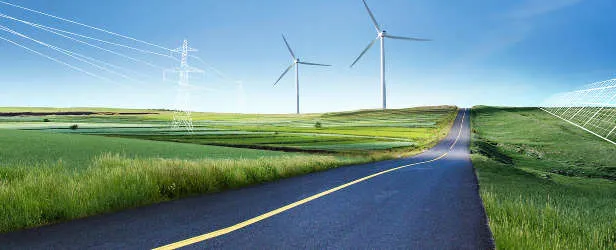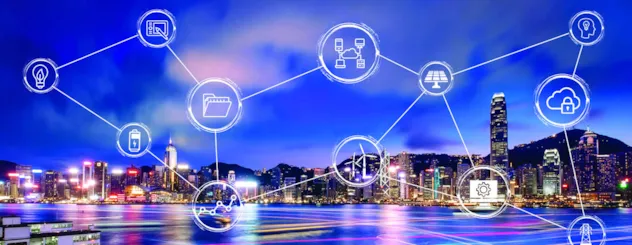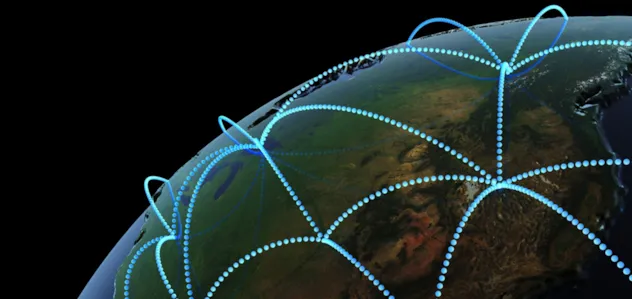September 07, 2017 | Podcast
Impact of ICT on energy ecosystems
Transcript:
Transcript:
00:00:00
Transcript:
NARRATOR Welcome to the DNV Talks Energy podcast series. Electrification, rise of renewables and new technologies supported by more data and IT systems are transforming the power system. Join us each week as we discuss these changes with guests from around the industry.
Transcript:
MATHIAS STECK In today’s episode of DNV Talks Energy, we will elaborate about the impact of information and communication technologies on the energy ecosystem. My guest to discuss this with is Andrew Milroy, Senior Vice President of the Digital Transformation Practice at Frost and Sullivan. Andrew spent over 20 years in the ICT industry and had assignments in the US, Europe and Asia Pacific. Welcome Andrew.
Transcript:
ANDREW MILROY Hi.
Transcript:
MATHIAS STECK Andrew, before we start, please could you briefly introduce yourself, tell us about your journey in the ICT industry and provide an overview, what Frost and Sullivan is doing?
Transcript:
00:00:56
Transcript:
ANDREW MILROY Okay. So, I’ve worked in this business for, as you say, over 20 years now, so I’ve seen a lot of changes take place in the IT industry and a lot of transformations occur as a result of the application of IT to different types of business activities. I look after Frost and Sullivan’s Digital Transformation Practice. What we do there is we look at the application of technology across different businesses and industries. So, we’re interested in looking at things like how the technology can change the way, for example, we consume and use media.
So, certain industries have been entirely transformed by technology. For example, the music one. Not too long ago, we would’ve gone out and purchased CDs, specific, discrete pieces of music. Today, the standard way of consuming music content is by streaming that music from the cloud onto a mobile device over a network. So, that industry has been completely transformed. And it’s a very good example of an industry that’s been transformed by the application of technology. So that kind of thing, we’re interested in, in the practice that I manage across the Asia Pacific region.
Transcript:
MATHIAS STECK So, talking about digital transformation and Frost and Sullivan’s business model, what does it directly mean to your company?
Transcript:
ANDREW MILROY Okay, so for our company, with that, again a very good question. Because usually we look at the impact of technology on other companies and other things. But, I mean, if you think about what we do – so we provide advisory services and research to clients who want to really understand the impact of this technology on their businesses. But when you look at ours, you know, potentially you could automate more of what I do. So, rather than having an analyst or a researcher do something, potentially you could have more artificial intelligence systems used that can answer certain questions you may have about a particular type of technology.
Transcript:
00:02:58
Transcript:
So, you might want to understand, for example, the cloud computing market in Indonesia. So, rather than going to a physical analyst, you might be able to use an AI system that could answer a lot of questions or give you templates, give you benchmarks, give you examples without so much human involvement. So, I think AI, artificial intelligence, and cloud computing, and networks, can potentially take some of the work off the shoulders of an analyst like myself. But I think ultimately, we’d end up working together with this type of technology to a greater extent than we currently do.
Transcript:
MATHIAS STECK On that point, so digitalization and big data are now, since quite a while, out there, recognised as disruptors, changing industries and business models, with lots of hopes and expectations towards new insights, efficiency, empowerment and these things. But of course, there are also threats, and you just mentioned that, for example, jobs go away.
Transcript:
ANDREW MILROY Yes.
Transcript:
MATHIAS STECK So, people are worried about high unemployment rates. So, when you look back, has there ever been a comparable breakthrough like this in the past, where people had these hopes and these worries?
Transcript:
00:04:03
Transcript:
ANDREW MILROY Again, it’s a very interesting question. But, I mean, really, you have to go way back. You have to go back to the Industrial Revolution, so the late 1700s. You know, Great Britain was the first country in the world to industrialize. And if you look at the labour market there, and there are records for this in the late 1700s, you know, 99%, a vast majority of the population, worked in agriculture. But within 40 or 50 years, the majority of the population had moved away from agriculture and started working in manufacturing. You could say something similar has been happening in China in a more condensed period of time. But that was a huge transformation, so a lot of traditional jobs went. And then, with more and more automation in the factories, then you had machines doing more of what people did, and you had social movements emerge that tried to protect labour. They had this movement called the Luddite movement, where they actually tried to trash, tried to damage and dispose of technology that they thought was replacing jobs. And we’re talking in the early mid-1800s when this was going on.
So, what we’re seeing today is nothing brand new. I think it’s been going on for, you know, many years, as long as we’ve been using automation and machines to replace human activities. But I think, you know, there’s been an escalation, it’s been speeding up in recent years, as we’ve seen the combination of cloud computing, mobile networks, big data and AI, and the internet of things emerge. So, they’re offering new possibilities for automating types of activity that we weren’t automating in the past. So, quite skilled jobs in manufacturing can be replaced now with robots, effectively. You know, quite skilled types of services sector jobs can be automated and replaced by chatbots, for example, by different types of bots that you can use. So, it’s having a profound effect.
Transcript:
00:05:54
Transcript:
But, you know, I know this is a very long answer I’m giving you, but there are negatives and there are positives. So, on the downside, of course, you see certain types of traditional jobs simply being eliminated, like the typing pools. Typing used to be a job until, you know, not too long ago. Those types of roles have now completely been eliminated. But what this technology typically has done is created new jobs. So, already, today, we see huge skill shortages in areas around the internet of things or artificial intelligence, for example. So, every internet of things system needs to be implemented by a human being in the first place. Somebody needs to manage it, someone needs to provide designing, someone needs to provide consulting services around it.
So, new types of opportunities emerge all the time. And, fingers crossed, we’ll manage it. But the challenge for governments and businesses and society is really to ensure that people with the old skills that become redundant have an opportunity to acquire new skills so as they can fill in the gaps in the new economy, as these new types of industries and jobs emerge.
Transcript:
MATHIAS STECK Yes, right, thank you. So I change topic a little bit, looking specifically at energy or, more precisely, at electricity, what impact, in your view, will the digital transformation have on the generation, transmission, distribution and use of electrons? And I’m looking a bit in the direction of shifting power maybe from utilities to the end user, enabled by things you just described.
Transcript:
00:07:25
Transcript:
ANDREW MILROY Yes. I mean, this is a very good point in this particular industry. So, the utilities industry has been not the earliest adopter of technology traditionally, and many would argue, because there’s been a semi-oligopolistic, monopolistic position that utilities have often been in; so, the degree of competition that they’ve faced has been lower than companies in other kinds of industries. But having said that, there are huge opportunities. A lot of the electricity grids that exist in rich countries are actually pretty old and need modernization, they badly need investment. Some would argue that the privatization that’s occurred in a lot of parts of the world has actually slowed down this investment, as the owners of the infrastructure are trying to get as much value as they can from the existing investment as possible.
But what today’s technology does is it makes it way more cost effective to do things like use internet of things technology in an electricity grid, from transmission through distribution to retail, because the cost of internet of things technologies – so such as actuators and chips that are connected to the internet that you can put in your grid – are going down and down and down and down. This cost is going down over time. So, you can do things like make your grid smarter in the way it uses renewables, versus non-renewable sources of energy.
Transcript:
00:08:49
Transcript:
So, one of the challenges we have with renewables typically is that it’s not constantly on. So, if you use solar power, for example, and suddenly you have clouds, then you have an issue with, you know, keeping the generation going. So, what technology can do today is make it very easy to switch from renewable to non-renewable as and when necessary, but optimize the amount of renewable energy that you generate, and ensure that you can store it effectively. So, these sensors that you can put in, you could have a console view of this grid and what’s happening at the generation level.
Now, as you said about power shifting to consumers, what we can also do is put consumers in a situation where they can control their energy consumption much more specifically with smart metering technology. I mean, many places have implemented smart metres to some extent or another. There are examples of it being used quite widely, this kind of technology. But what it can enable you to do is choose to use electricity at times when the cost is lower, for example, when doing your washing. So, you can just control that usage to a much greater degree than you might’ve traditionally been able to do.
You might also be able to, you know, generate electricity. Again, in many parts of the world, this is happening, you know, through solar-powered panels in your own home; generate electricity yourself and add this to the grid and get discounts on how much you spend and so on. So, it just creates a lot more flexibility and agility and allows the consumer to have a lot more control on what energy they consume, how they consume it, and allow them potentially to also contribute to the generation of energy in the grid.
Transcript:
00:10:32
Transcript:
MATHIAS STECK Right. So obviously, there is a lot of benefit in being connected, utilizing assets better, and empower the sustainable use of energy. But when it comes to the communication which is required to enable all of this, there are two things which strike me. First of all, we need, kind of, protocols to make that happen. And second of all, these protocols need to be very safe to prevent cyberattacks. What are your thoughts on that aspect?
Transcript:
ANDREW MILROY Again, yes, this is one of the big issues. I mean, I think the issue of standards and protocols is less of an issue because there’s a lot of software out there, a lot of, you know, IoT platforms that are out there, a lot of IoT technology that’s out there and what internet of things is, and what it’s designed to do, or internet of things gateways, is to aggregate data coming from different sources and basically translate it in a way that can be understood. So, that is something we have the technology to address, these varying standards and varying protocols. I mean, I’m not saying it’s easy, but it’s addressable; it’s something that can be done.
Now, I think the bigger challenge is the one you mentioned which is to do with cybersecurity. Because electricity grids – I mean, that’s critical infrastructure. So, the more of that that is exposed to hackers, the more risk there is that a hacker can potentially bring down the electricity infrastructure of a country, that we saw happen recently in the Ukraine. So, it’s something that really needs to be taken care of. And I know that in some parts of the world, it’s actually inhibiting innovation in the use of technology.
Transcript:
00:12:11
Transcript:
I know in South Korea, there’s a lot of concern about it because often the infrastructure, the critical infrastructure in South Korea is uniquely vulnerable in the sense that their neighbours – and it’s understood or it’s widely thought – that the neighbours in the North, are constantly seeking ways of undermining the South Korean economy. And one of those ways is by hitting critical infrastructure and causing as much damage as possible. So, they’ve had to be very conservative in their use of technology – that is, the South Korean utilities – because obviously, safety comes first.
So, we’re going to start moving away from the language of cybersecurity, I think, and we’ll be looking more at safety. So, we’ll start saying, as we implement this new type of technology, is it safe? Are we 100% sure that this internet of things technology is not hackable? And that’s going to be a real, real major challenge, moving forward.
So, I think you kind of hit the nail on the head when we talk about that. Much of them, a lot of the great stuff we know technology can do, it can do, and it’s out there, and it’s all doable. The technological challenges are all surmountable. Even the skills issues, even the manpower issues are surmountable. There are quite clear ways of addressing these issues. However, cybersecurity – you know, there are still many, many challenges. So, that is the big issue and will probably act as the biggest inhibitor or hindrance to the deployment of new technology in the energy sector.
Transcript:
00:13:41
Transcript:
MATHIAS STECK Very good. And there is another big issue out there which I want to frame the last question around. So, I want to tie the digital transformation together with COP21, COP22 and the imperative of decarbonization. So, as my last question, I would like to ask you, what can ICT technology do to help us prevent climate disruption?
Transcript:
ANDREW MILROY Okay. So, I think, you know, fundamentally, I mean, we’re moving more towards renewables, but fundamentally, it can make this whole process more manageable. So, as I, you know, mentioned earlier, from a generation perspective, it can optimize the use of renewable technology – wave power, wind power, solar power, for example – by maximizing the amount of energy that’s generated when the conditions are right, to generate this energy and store it, and store a lot of it. I think that fundamentally, technology can enable us to do this to a much greater extent than we’re doing, and it’ll change the economics also, to make it increasingly more economical to use renewables rather than non-renewables.
Transcript:
00:14:53
Transcript:
I think, from a consumer perspective, I know there are certain parts of the world where people are more concerned about renewable, about carbonization than in other parts of the world. And I think we can have a situation where it can give people an opportunity to ensure that the kind of energy that they are using is renewable. And I think in many parts of the world, people would be, you know, very keen to do that. So, I think it can really help us expedite this move towards renewables.
Transcript:
MATHIAS STECK Many thanks, Andrew. Many thanks for your valuable insights. Many thanks, everyone, for listening. This was Andrew Milroy from Frost and Sullivan, elaborating about the impact of information and communication technologies on the energy ecosystem.
Transcript:
NARRATOR Thank you for listening to this DNV Talks Energy podcast. To hear more podcasts in the series, please visit dnvgl.com/talksenergy.
Transcript:
00:15:50


